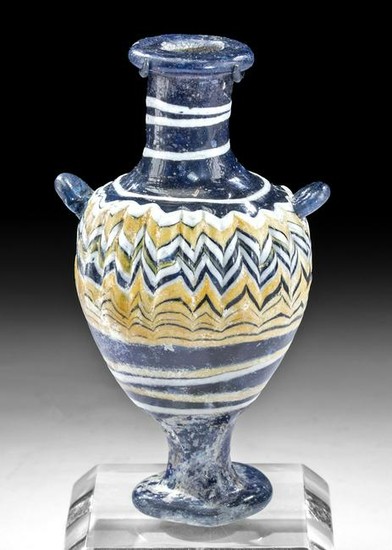Stunning Greek Core Form Glass Amphoriskos
Ancient Greece, ca. 6th to 4th century BCE. A beautiful example of a core-formed glass amphoriskos once used to hold aromatic oils. The vessel boasts an elegant form with a piriform body that is subtly contoured with vertical ribs and twin trail nubbin handles gracing the shoulders, a tubular neck, and a gently flared, flattened rim, all upon a splayed pedestal foot. The decoration of this piece is simply gorgeous, with the dark cobalt blue body wound with tangerine yellow-orange and white trails applied in a close-knit feathered pattern. Additional white trailing spirals around the shoulder and neck, and even more white and tangerine trails encircle the lower section of the vessel. An opulent example of glasswork to be treasured for its pristine form, lustrous sheen, fabulous hues, sophisticated technique, and silvery/rainbow iridescence gracing the foot. Size: 1.875" W handlespan x 3.3" H (4.8 cm x 8.4 cm); 3.75" H (9.5 cm) on included custom stand.
A vessel like this would have been made for the elites of ancient society. Its owner would have used a stopper to keep the contents inside, and a glass rod to dip into the vessel's perfumed oils and dab on the throat or wrists.
The Greeks created core-formed or sandcore vessels by trailing threads of molten glass over a "core" of sand or clay to form the vessel. These threads were oftentimes feathered or dragged to create intriguing decorative patterns. The term amphoriskos literally means "little amphora" and this example is indeed a miniature amphora. This shape was quite popular as it was ideal to store precious oils, perfumes, or cosmetics.
According to the Corning Museum of Glass, core forming is "the technique of forming a vessel by winding or gathering molten glass around a core supported by a rod. After forming, the object is removed from the rod and annealed. After annealing, the core is removed by scraping." (https://www.cmog.org/glass-dictionary/core-forming). This process of glass making was begun in the late 16th century BCE by glassmakers of Mesopotamia, and then adopted by Egyptian glassmakers in the 15th century BCE. The technique almost came to an end in the so-called Dark Ages of Mediterranean civilization (1200 to 900 BCE); however, by the 9th century BCE a new generation of glassmakers took up the technique once again, and between the 6th and 4th century BCE core-forming spread throughout the Mediterranean.
Provenance: private East Coast, USA collection; ex-Martin J. Wunsch collection, New York, USA, acquired in the 1980s
All items legal to buy/sell under U.S. Statute covering cultural patrimony Code 2600, CHAPTER 14, and are guaranteed to be as described or your money back.
A Certificate of Authenticity will accompany all winning bids.
We ship worldwide to most countries and handle all shipping in-house for your convenience.
#147786
Condition Report: One nubbin handle appears to have been reattached. Otherwise excellent. Marvelous iridescence on the foot.
View it on
Estimate
Time, Location
Auction House
Ancient Greece, ca. 6th to 4th century BCE. A beautiful example of a core-formed glass amphoriskos once used to hold aromatic oils. The vessel boasts an elegant form with a piriform body that is subtly contoured with vertical ribs and twin trail nubbin handles gracing the shoulders, a tubular neck, and a gently flared, flattened rim, all upon a splayed pedestal foot. The decoration of this piece is simply gorgeous, with the dark cobalt blue body wound with tangerine yellow-orange and white trails applied in a close-knit feathered pattern. Additional white trailing spirals around the shoulder and neck, and even more white and tangerine trails encircle the lower section of the vessel. An opulent example of glasswork to be treasured for its pristine form, lustrous sheen, fabulous hues, sophisticated technique, and silvery/rainbow iridescence gracing the foot. Size: 1.875" W handlespan x 3.3" H (4.8 cm x 8.4 cm); 3.75" H (9.5 cm) on included custom stand.
A vessel like this would have been made for the elites of ancient society. Its owner would have used a stopper to keep the contents inside, and a glass rod to dip into the vessel's perfumed oils and dab on the throat or wrists.
The Greeks created core-formed or sandcore vessels by trailing threads of molten glass over a "core" of sand or clay to form the vessel. These threads were oftentimes feathered or dragged to create intriguing decorative patterns. The term amphoriskos literally means "little amphora" and this example is indeed a miniature amphora. This shape was quite popular as it was ideal to store precious oils, perfumes, or cosmetics.
According to the Corning Museum of Glass, core forming is "the technique of forming a vessel by winding or gathering molten glass around a core supported by a rod. After forming, the object is removed from the rod and annealed. After annealing, the core is removed by scraping." (https://www.cmog.org/glass-dictionary/core-forming). This process of glass making was begun in the late 16th century BCE by glassmakers of Mesopotamia, and then adopted by Egyptian glassmakers in the 15th century BCE. The technique almost came to an end in the so-called Dark Ages of Mediterranean civilization (1200 to 900 BCE); however, by the 9th century BCE a new generation of glassmakers took up the technique once again, and between the 6th and 4th century BCE core-forming spread throughout the Mediterranean.
Provenance: private East Coast, USA collection; ex-Martin J. Wunsch collection, New York, USA, acquired in the 1980s
All items legal to buy/sell under U.S. Statute covering cultural patrimony Code 2600, CHAPTER 14, and are guaranteed to be as described or your money back.
A Certificate of Authenticity will accompany all winning bids.
We ship worldwide to most countries and handle all shipping in-house for your convenience.
#147786
Condition Report: One nubbin handle appears to have been reattached. Otherwise excellent. Marvelous iridescence on the foot.



